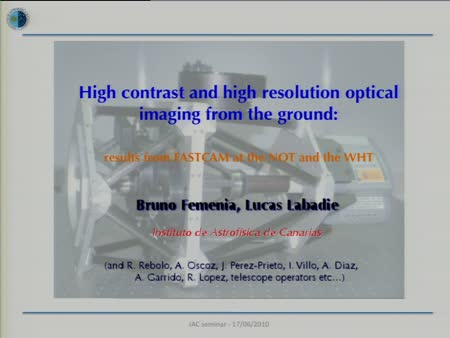Found 4 talks width keyword diffraction limit

Abstract
I will summarize the two well proved techniques for high spatial resolution: Lucky Imaging and Adaptive Optics and the work of our group in this field. I will also introduce the state-of-the-art new instrument Adaptive Optics Lucky Imager (AOLI). On AOLI, both techniques merge providing a very versatile answer on the visible range. Some first science on the T-Tauri system LkHa 262/263 in the MBM 12 cloud will be reported together with a review of the next steps to be developed.

Abstract
CANARY is a technical demonstrator for the proposed EAGLE instrument for European ELT. EAGLE will have twenty Integral Field Units patrolling a 5 arcminute field and requires a new form of adaptive optics to provide the required image quality for its 0.0375 arcsec image sampling: Laser Guide Star Multi-Object AO. This entails several significant technical innovations: open-loop control, atmospheric tomography, and new calibration methods. The CANARY demonstrator is currently in its first, natural guide star, phase, and the first results have been obtained on sky. CANARY Phase A is described and the first results are presented. The next, laser guide star, phase is then outlined.

Abstract
Developed since 2006 by the IAC and UPCT, FASTCAM is an optical camera which takes advantage of recently available low noise and fast read-out CCDs (with integration times ~30 ms) to perform speckle imaging of astrophysical sources. At high enough speed rate, the atmospheric turbulence - classically responsible for image degradation , i.e. seeing- can be frozen in the image, which permits us to implement "lucky imaging techniques". In this shared talk, we will review the principle and objectives of the instrument (mainly oriented so far towards the study of brown dwarfs), we will present the results obtained in different campaigns at the NOT and WHT telescopes stressing the effort towards high contrast and high resolution optical imaging potential which can be further enhanced with post-processing techniques. In this talk we will also discuss some ideas for future projects and scientific applications, possibly in conjunction with the GTC.
Abstract
I will present a short introduction to speckle imaging and the so-called speckle holography technique. Subsequently, I will present results of speckle observations with the VLT (NACO) and Keck (NIRC) telescopes. The experiments demonstrate that in the observed targets speckle imaging combined with holographic image reconstruction provides imaging quality that can compete with and even supersede current adaptive optics (AO) imaging systems. Speckle imaging is a way to achieve reliable, high-quality, diffraction limited imaging capacity at relatively low costs. I will discuss what would be the estimated performance of speckle cameras at the WHT and GTC and sketch possible concepts.« Newer Older »
Upcoming talks
- Classical Be stars - Constraining binary interaction physics in massive starsDr. Julia BodensteinerThursday April 25, 2024 - 10:30 GMT+1 (Aula)








